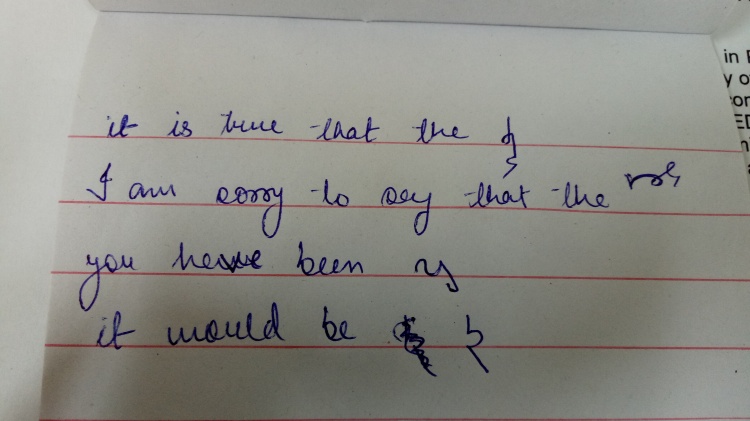Learning shorthand requires not only practice but also interest in this field. Many people give it up during the first few days of understanding its concept. But once you get the gist and basic understanding of shorthand, it actually becomes quite easy. And with regular practice, one can easily improve their speed.
There were some suggestions and tips from friends, teachers and from the Internet (Google, of course) that helped me to a great extent. And believe me when I say, reaching the goal of writing at 120 wpm is not that difficult. Lucky for us, SSC only asks for a speed of 100wpm for the post of Grade C, but as many of you would have heard your teachers and friends say, to write at any speed, you need to be able to write at a speed above that.

For eg. if you want to be able to write at 100wpm, you need to be able to achieve taking dictations at 110-120 wpm. Only then, would 100wpm seem like a piece of cake.
So here are the tips and tricks that you can use to increase your speed:
- The first rule, that is very very important, is to always use phrases together. for eg. it is true that the, you have been, etc. You need not learn big and difficult phrases that are hard to remember and may clash with other outlines too, but do make it a habit to use outlines of those phrases that are common and occur in almost all the dictations. Making a single outline for every word is not possible when you write at 120 wpm or aim to achieve higher speeds.

- Secondly, as soon as you hear a word that is new or difficult, leave it immediately. Do not force yourself to create an outline for that word, as you might not be able to recall it during transcriptions. Also, you might miss out on taking down the next 3 to 4 words that might have been easy and that would make you lose out on one full line. This increases your chance of making more errors while transcribing.
- When taking down names of countries or states or name of an organization, practice using short forms for such words in longhand. Believe me, SSC is not going to deduct your marks for using one or two longhand words or alphabets, to be precise, in your short hand dictations. The only rule here is that you do not write the full dictation only in long hand, and trust me, that is also not possible. I have sometimes written full spellings of words whose outlines I could not remember during 100 wpm dictations and never lost any marks. I still do that!
- In view of the above point, do write down spellings of some words if you are unable to recall their outlines. It happens sometimes that even being good at shorthand, we might not be able to produce the right outline of even simple words and that’s okay! Just be sure to make their outlines after you have finished taking down the dictation, just above the spelling of the word. The examiner checking your note pad will be assured about your accuracy.

- Now, you might think how is it possible to write spellings or full words while writing at 120wpm. That, my friend, comes through practice. When your hand moves fast enough that it does not tire out soon, you will be amazed how easily the dictation flows out on your note pad. And that practice comes by making your hand move! (quite literally) For those who are just starting to learn shorthand, make it your habit to just scribble for 5 to 10 minutes on your note pad. Even when you practice looking from the books, write fast and let your hand move. Do not worry about your writing being illegible (not clear enough to be read). As you gain speed, your writing will improve and with confidence, you will be able to easily take dictations.
- Take the help of recorded dictations. They do help, and a lot! I was already working when I starting preparing for Lok Sabha Reporter’s Exam. Although I was unable to clear it, I did find improvement in my speed. Every day after the morning class, I would practice from the recorded dictations. Transcribe this dictation and tally it with the recording, then check where you made errors, look for the phrases that can be written together and again take that dictation. Do this 2 to 3 times a day and you will start to see improvement. This self-assessment would build your confidence.
- Always while transcribing, even when you are just practicing, follow the rules of grammar, punctuation etc. Do not leave it for afterwards, because you would not remember it while giving the actual test. Also, always give a tab when transcribing your dictation. That space by the tab marks the beginning of your paragraph. And it is not necessary to create a new paragraph. If you are unsure of where the new paragraph begins, just continue writing in the same one. Creating a wrong paragraph will be counted as error.
- Correct your spellings or mistakes while transcribing itself. Sometimes, you might not get enough time to do that during your revision.
- While transcribing during practice sessions, always keep a timer. Most of the competitive exams that conduct skill test do so on computers on a software where there is a timer which stops your working area as soon as your time for transcription is over. Keeping a timer with you while practice will prepare you for the actual test and you can also monitor your typing speed and work on it.
Many of you would be aware of these points and would not think of this as something new to read. But if you have friends who are newbies in the field of shorthand, do pass this on. Also, if you have anything else to add on to these points, do mention them in the comment section below.
Keep practicing!
Take Care!

Great initiative,
LikeLiked by 1 person